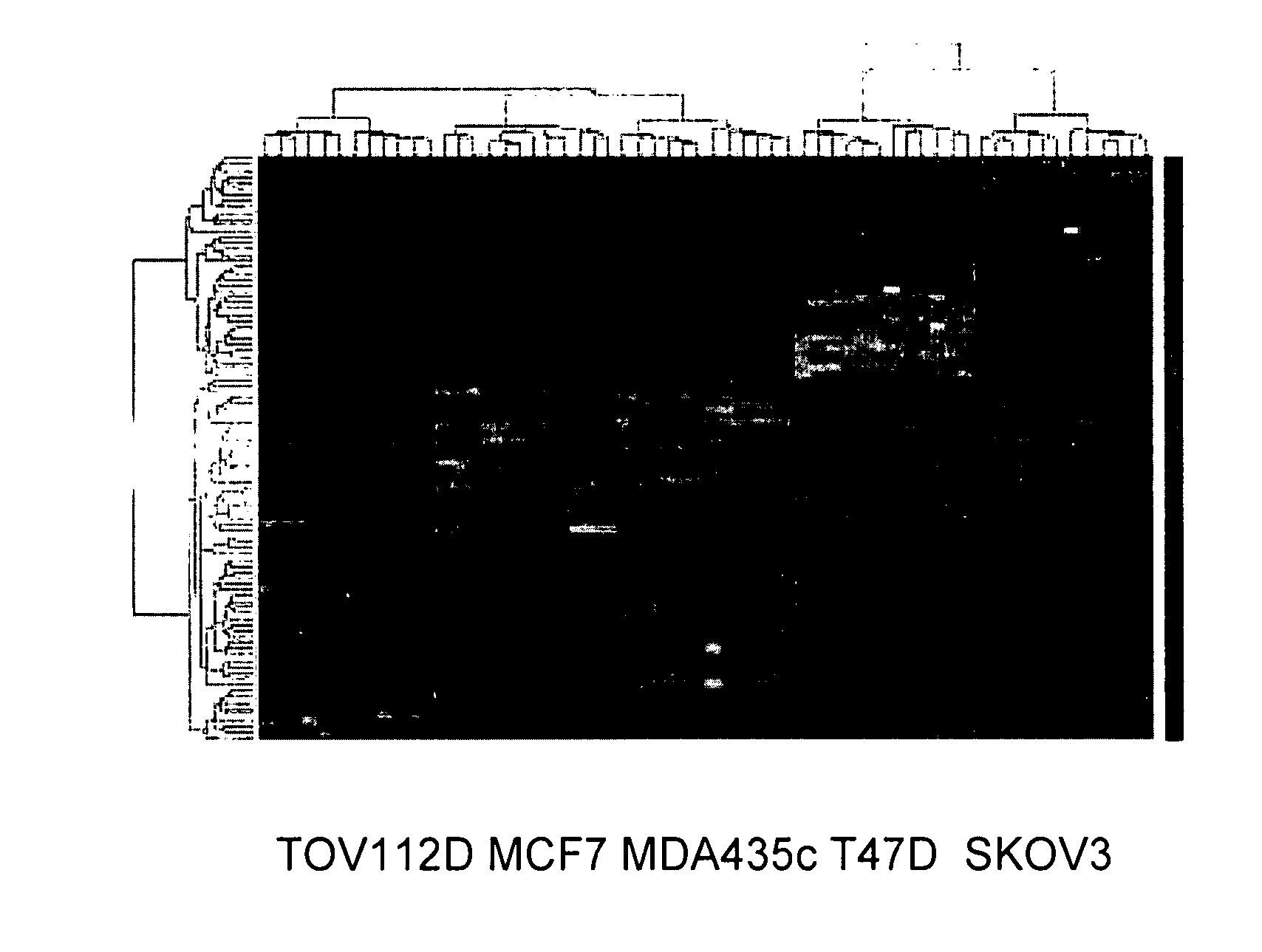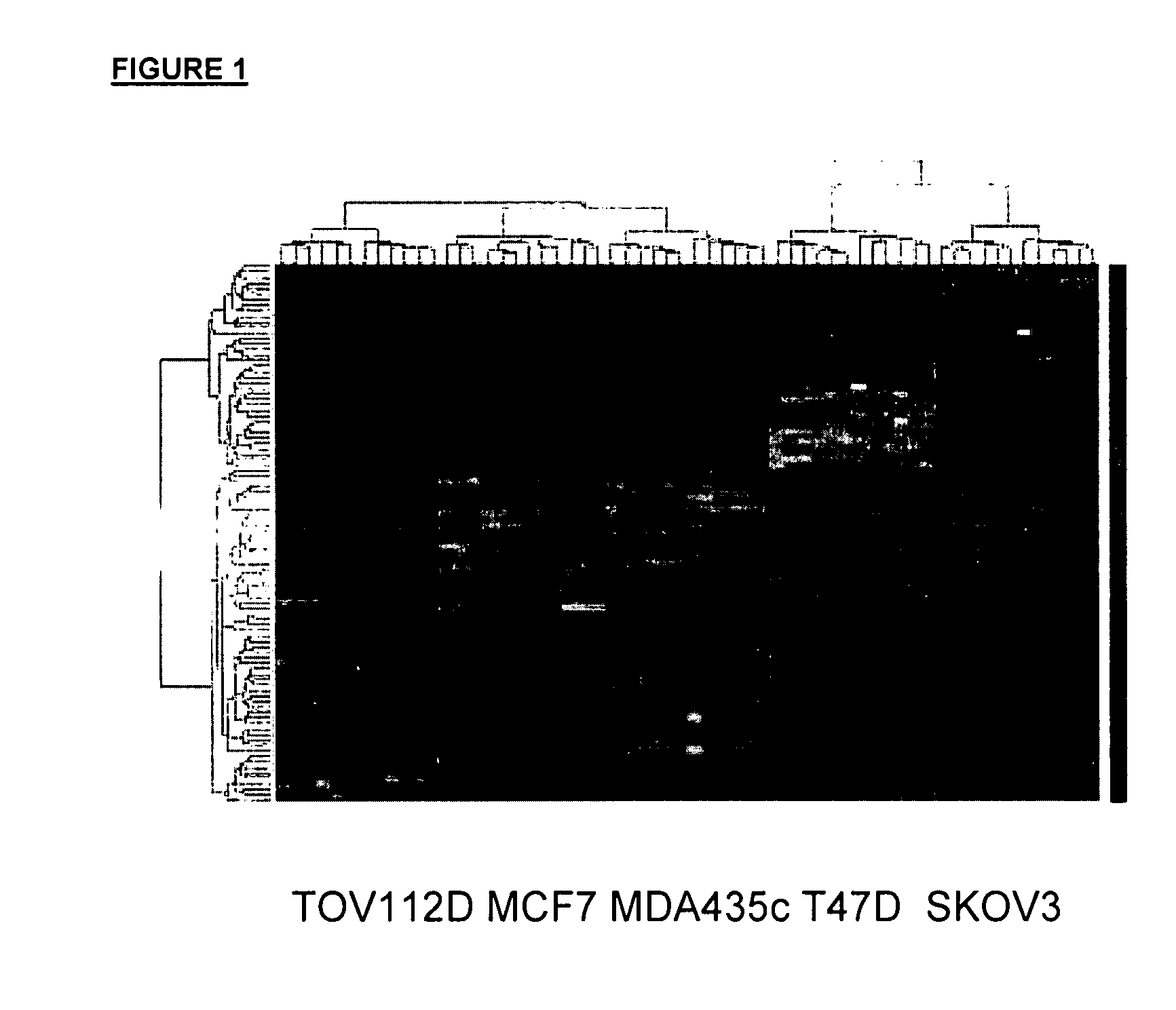Panel of biomarkers for prediction of fti efficacy
a biomarker and efficacy technology, applied in the field of panel of biomarkers for predicting fti efficacy, can solve the problems of cancer growth and spread, negative effect on patient treatment outcome,
- Summary
- Abstract
- Description
- Claims
- Application Information
AI Technical Summary
Benefits of technology
Problems solved by technology
Method used
Image
Examples
example 1
Identification of Biomarkers
[0136] In this example, biomarkers which are upregulated or downregulated in lonafarnib sensitive cell lines, relative to that of resistant cell lines T47D and SKOV3 were identified.
RNA Isolation
[0137] Cells were grown in 10 cm plates in triplicate and treated with DMSO or lonafarnib for 24 or 72 hours. The cells were then pelleted and snap frozen in liquid nitrogen and stored at −80° C. RNA was isolated using the Trizol reagent, following the manufacturer's instructions, and further purified the RNA by passing it over an RNAeasy column from Qiagen. RNA quantity and quality was assessed by measuring OD260 / 280 ratios and by gel electrophoresis.
Microarrays
[0138] Approximately 5 ug of total RNA was used for first and second strand cDNA synthesis. After purifications the cDNAs were in vitro transcribed to cRNAs. The biotinylated cRNAs were then fragmented and hybridized to Affymetrix Human U133 plus 2.0 arrays, according to the manufacturer's instructi...
example 2
Lonafarnib Sensitivity Correlates with Biomarker Expression
[0141] Analysis of the microarray data resulted in a gene list of 98 genes that were differential regulated in sensitive vs. resistant cell lines, n both the breast and the ovarian derived samples. Twenty two of these genes were chosen for follow up, based on a combination of statistical significance, robust expression and biological interests. The 22 genes which were the subject of the follow up investigation were: PRL2, claudin-1, LIM kinase 2, NM—211596, ZTNF2, FRAG1, Mucin-1, NM—224461, PDGFRL, TBX2, PDCD8, ARMCX1, APLP2, XRN1, HLAC, CRIM, LTB4DH, SLC3A2, NLGN4AX, affimextix id. 242346-X-AT (AK124454), TIGA, OPN3, ODAG, RBMX2, MOSPD1 and ARD1A. Gene expression for these 22 genes was confirmed by RT-PCR in the 5 cell lines and then expanded to a larger panel of 22 additional cell lines (FIG. 1). The expression pattern of six genes was found to be consistently differentially regulated (when comparing sensitive to resistan...
PUM
| Property | Measurement | Unit |
|---|---|---|
| Fraction | aaaaa | aaaaa |
| Therapeutic | aaaaa | aaaaa |
| Responsivity | aaaaa | aaaaa |
Abstract
Description
Claims
Application Information
 Login to View More
Login to View More - R&D
- Intellectual Property
- Life Sciences
- Materials
- Tech Scout
- Unparalleled Data Quality
- Higher Quality Content
- 60% Fewer Hallucinations
Browse by: Latest US Patents, China's latest patents, Technical Efficacy Thesaurus, Application Domain, Technology Topic, Popular Technical Reports.
© 2025 PatSnap. All rights reserved.Legal|Privacy policy|Modern Slavery Act Transparency Statement|Sitemap|About US| Contact US: help@patsnap.com



